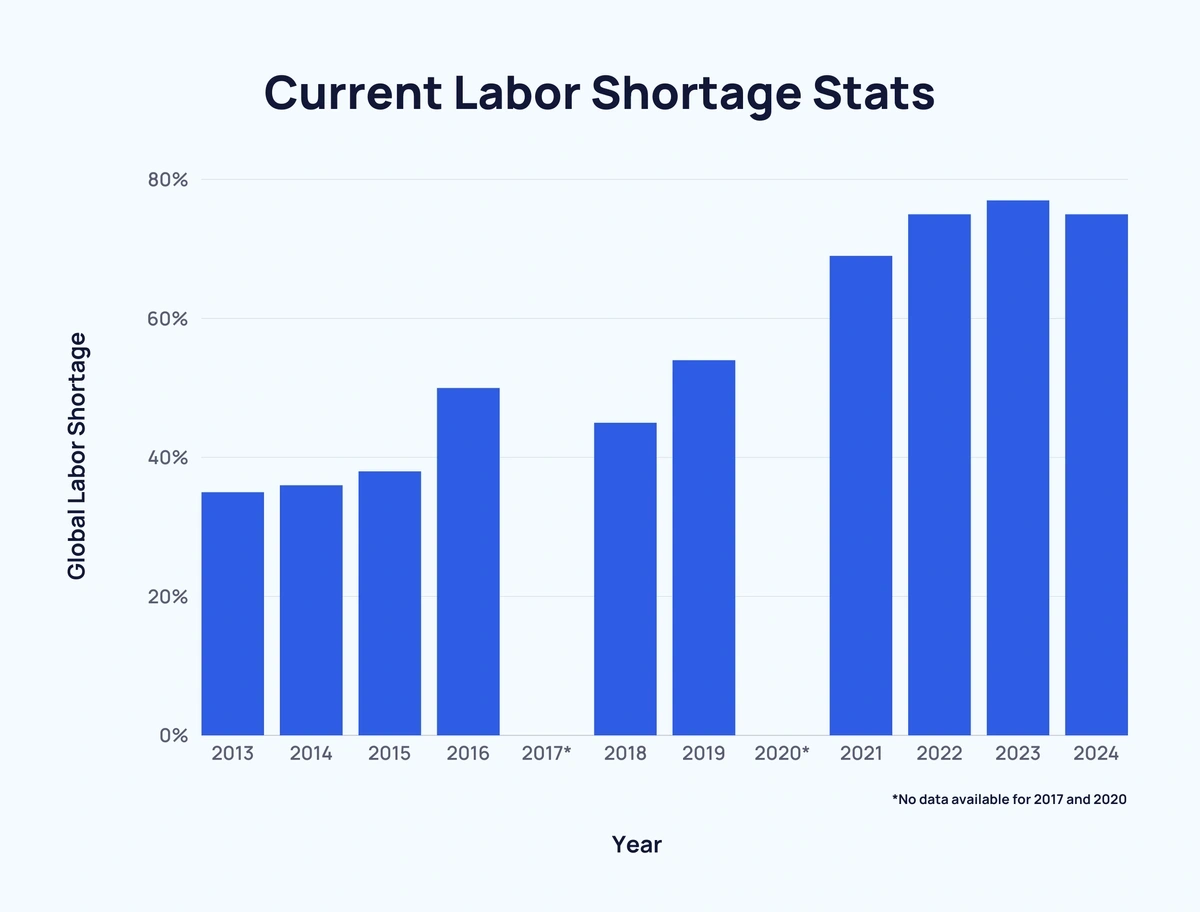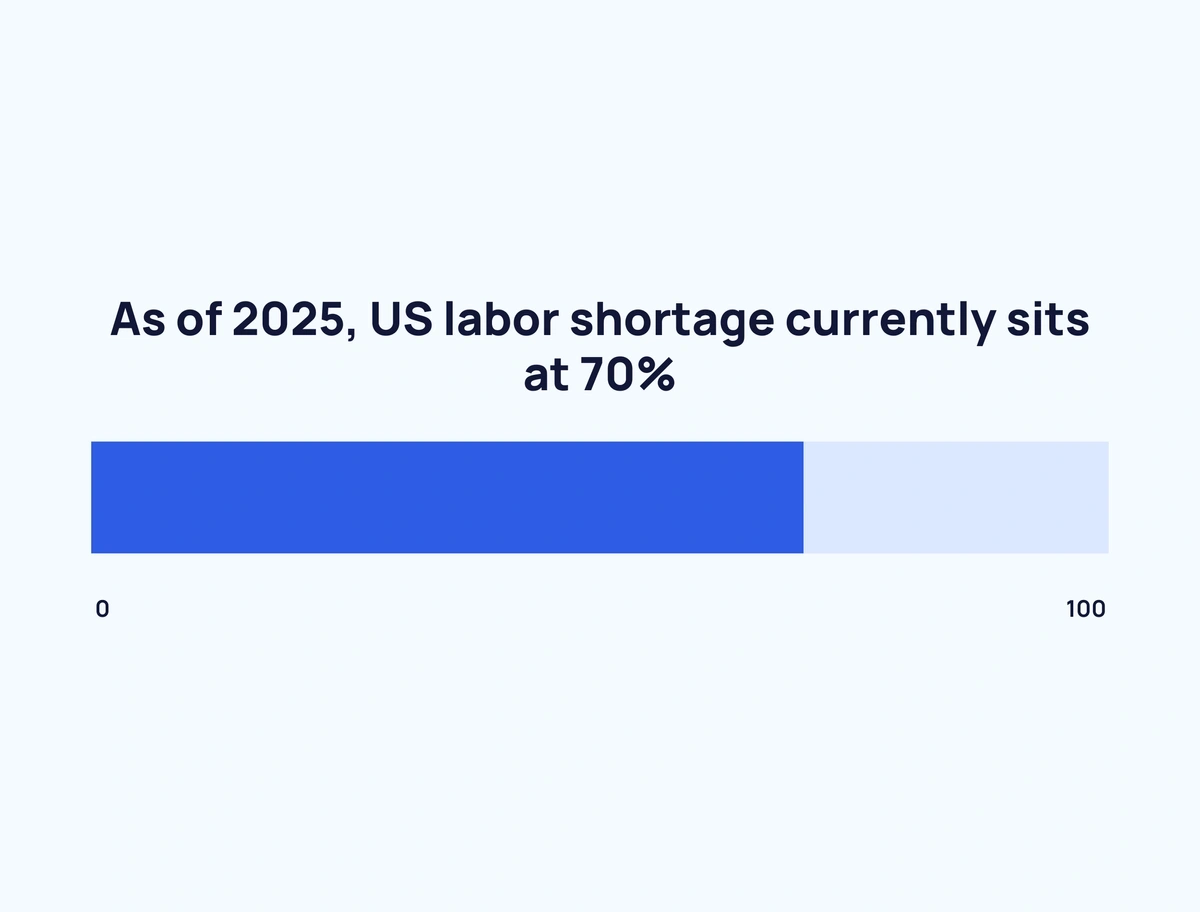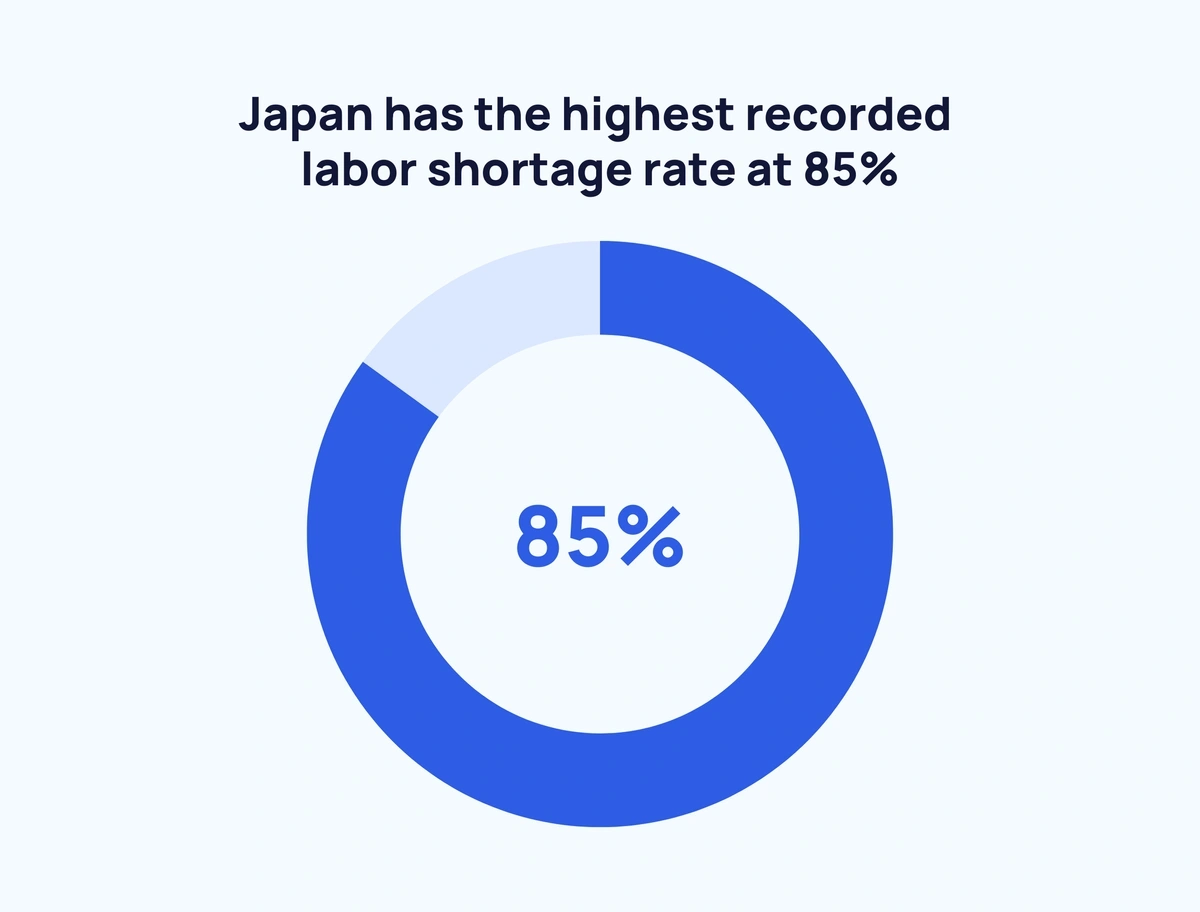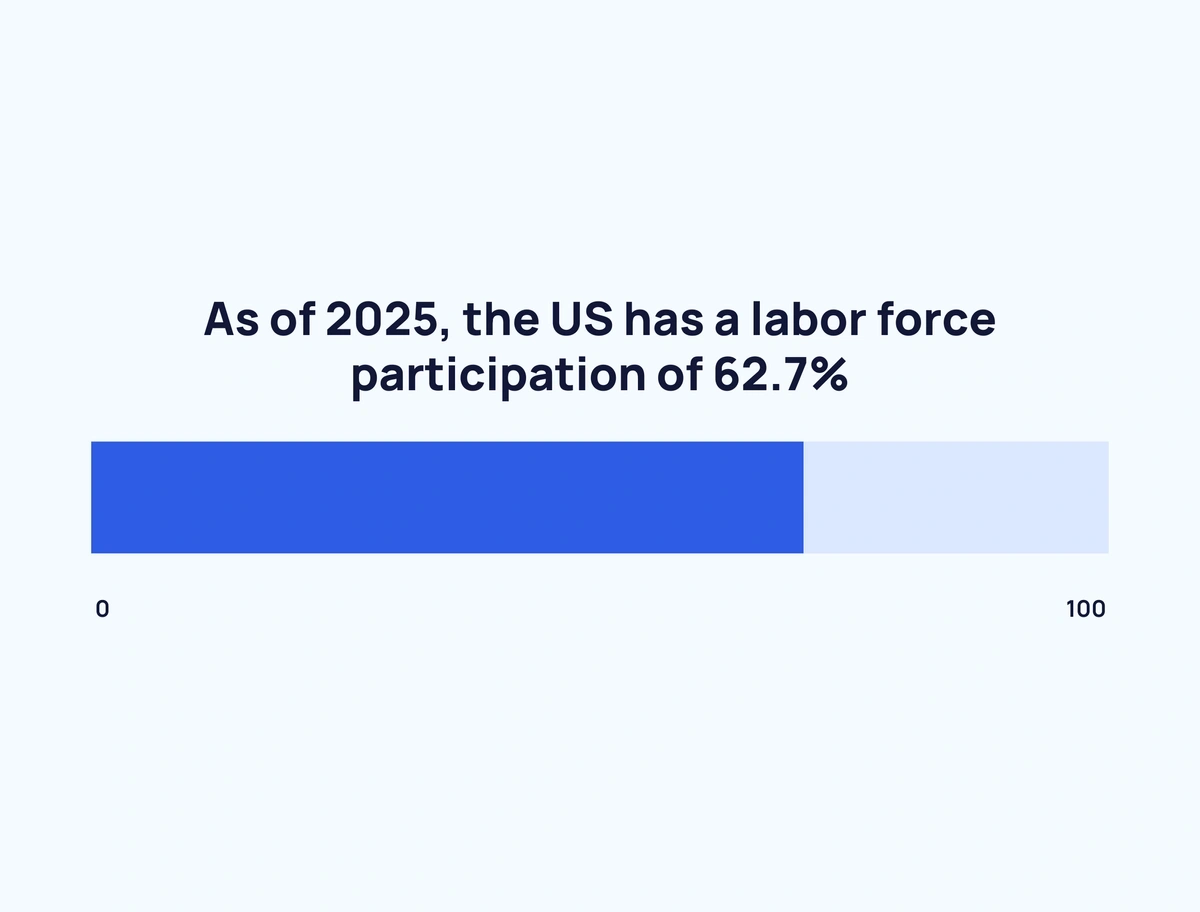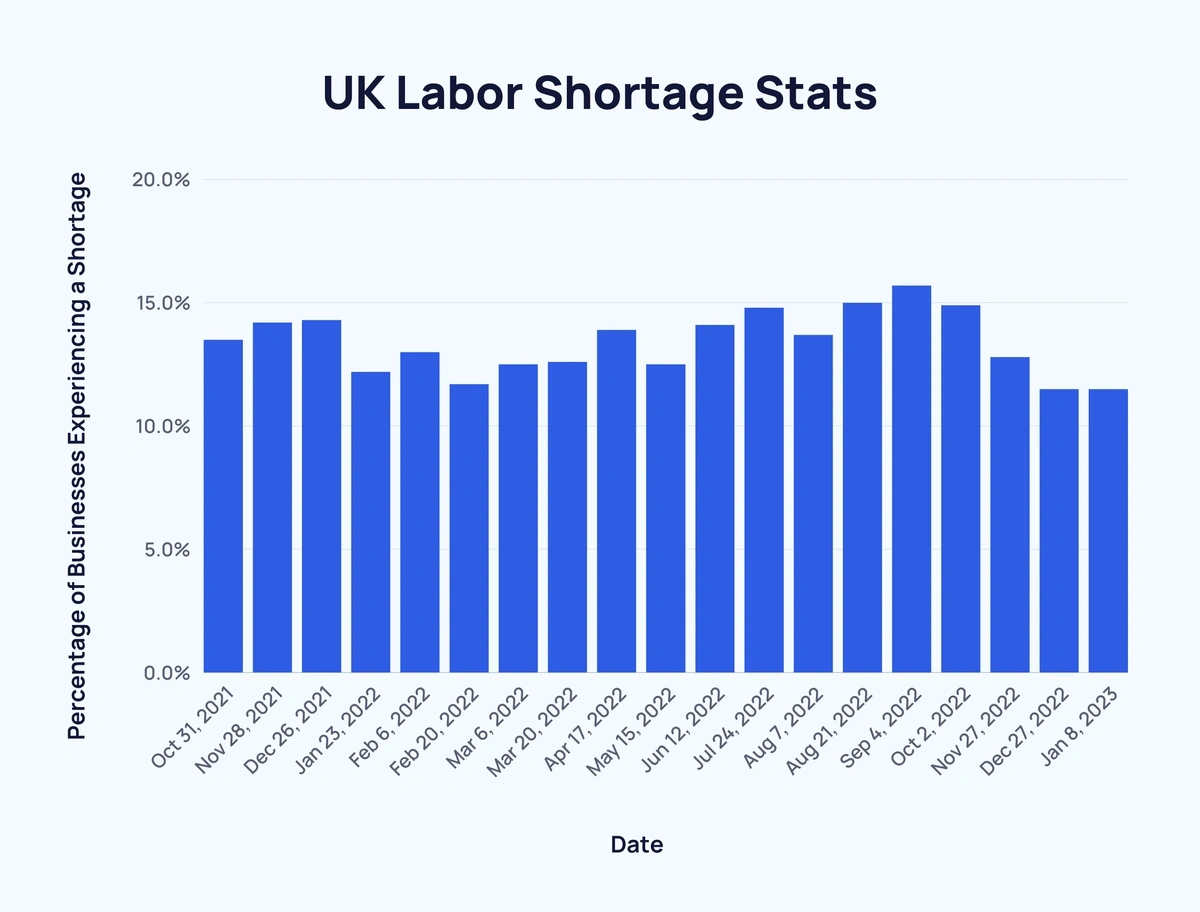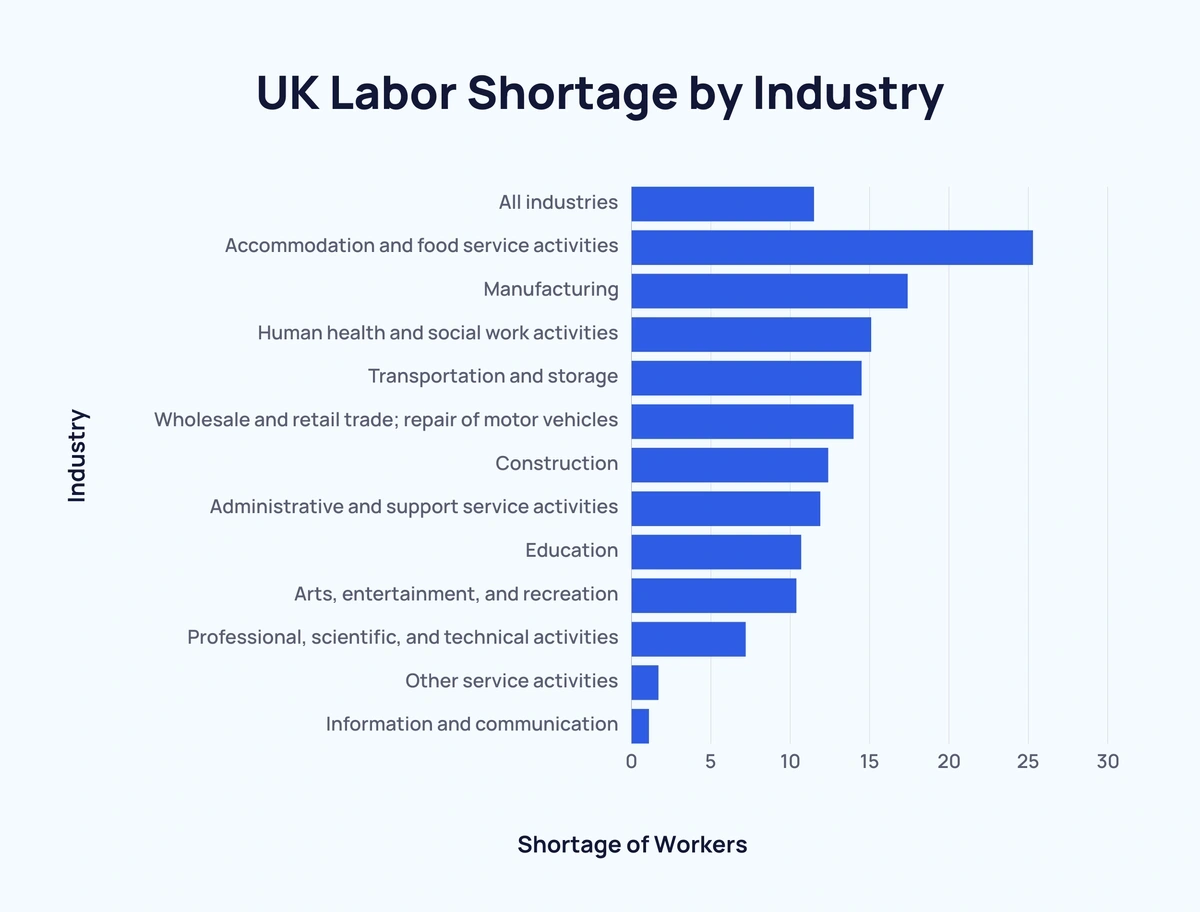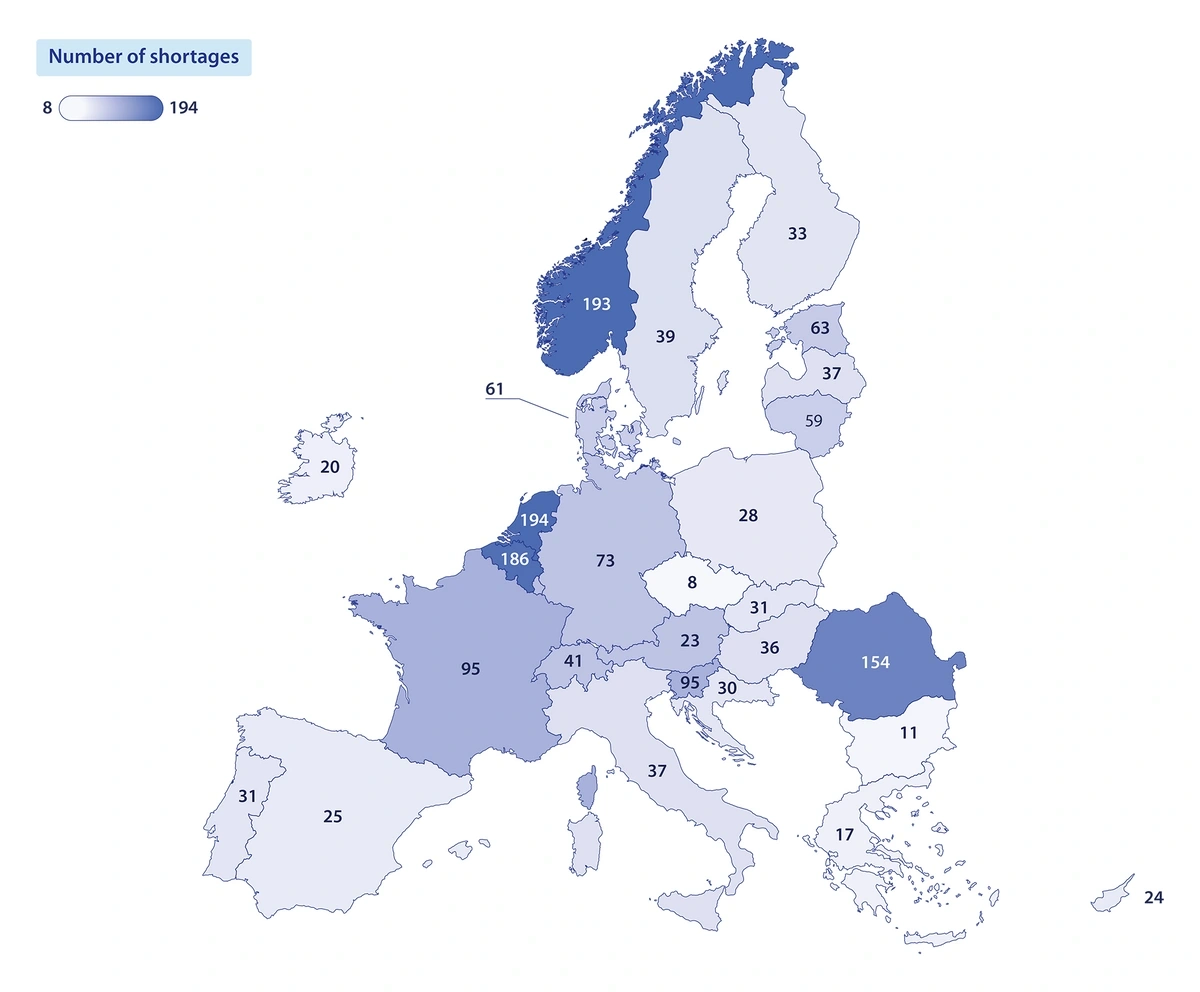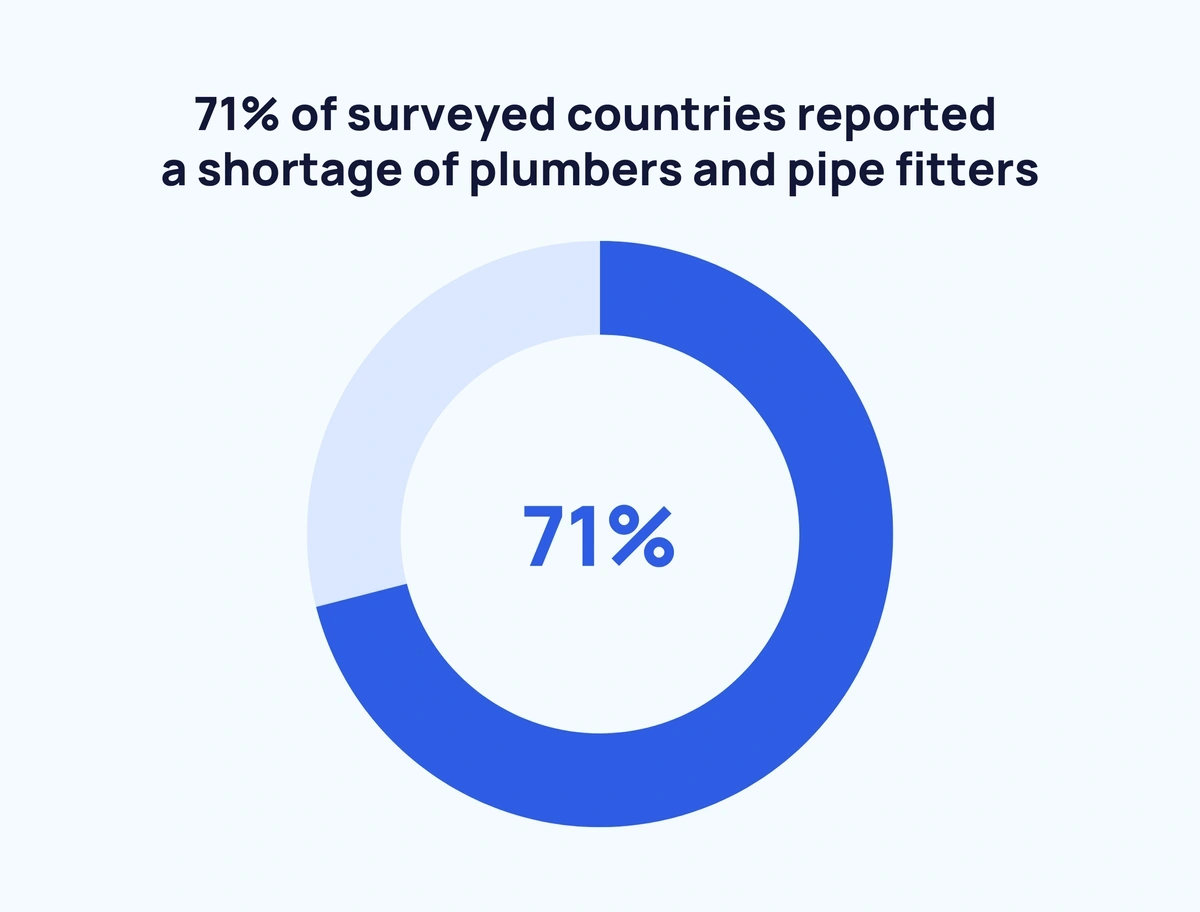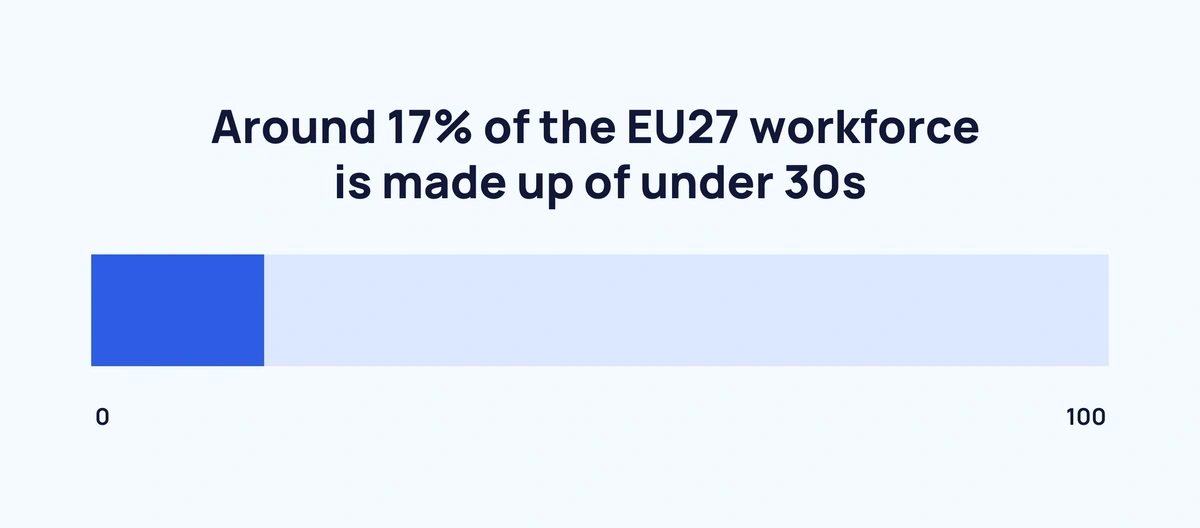
The Latest Labor Shortage Trends & Statistics (2025)
With labor shortages on the rise, employers are understandably concerned.
Yet some industries are suffering more than others.
Below, we’ll dive into the latest data surrounding global labor shortages and other relevant statistics.
Top Labor Shortage Statistics 2025 (Editor’s Picks)
- 75% of employers are not able to fill job vacancies
- The US has a labor shortage of 70%
- The US has a labor force participation of 62.7%
- The Netherlands has 194 occupations with labor shortages, the most in Europe
- Welders and flame cutters are the most in-demand professionals in Europe (21 countries)
Current Labor Shortage Stats
According to ManpowerGroup, three-quarters (75%) of employers are struggling to fill job vacancies – that’s the second-highest figure on record since surveys began in 2006, although it’s down from 2023 (77%)
In fact, the number of employers reporting labor shortages has almost doubled since 2015 (38%).
Here’s a look at global labor shortage figures over the last decade:
| Year | Global Labor Shortage | Change Over Previous Recorded Year |
| 2013 | 35% | - |
| 2014 | 36% | +1% |
| 2015 | 38% | +2% |
| 2016 | 50% | +12% |
| 2017 | - | - |
| 2018 | 45% | -5% |
| 2019 | 54% | +9% |
| 2020 | - | - |
| 2021 | 69% | +15% |
| 2022 | 75% | +6% |
| 2023 | 77% | +2% |
| 2024 | 75% | -2% |
Source: ManpowerGroup
US Labor Shortage Rates
In the US, talent scarcity is on the rise.
As of 2025, US labor shortage currently sits at 70%, five percentage points below the global average.
That means that 7 in 10 employers are unable to find suitable employees for their job vacancies.
Source: ManpowerGroup
Want to Spy on Your Competition?
Explore competitors’ website traffic stats, discover growth points, and expand your market share.
Labor Shortage Rates By Country
Japan has the highest recorded labor shortage rate at 85%. That’s 10% higher than the global average.
On the other end of the scale, Finland has a labor shortage rate of 59% - 16% lower than the worldwide rate.
Here’s a breakdown of labor shortages for selected countries across the world:
| Country/Territory | Region | Labor Shortage |
| Global Average | - | 75% |
| Japan | Asia | 85% |
| Germany | Europe | 82% |
| Israel | Asia | 82% |
| Greece | Europe | 82% |
| Ireland | Europe | 81% |
| India | Asia | 81% |
| Portugal | Europe | 81% |
| UK | Europe | 80% |
| France | Europe | 80% |
| Canada | North America | 80% |
| Brazil | South America | 80% |
| Singapore | Asia | 79% |
| Romania | Europe | 79% |
| Slovakia | Europe | 79% |
| Hong Kong | Asia | 79% |
| Spain | Europe | 78% |
| Puerto Rico | North America | 78% |
| Australia | Oceania | 78% |
| Austria | Europe | 78% |
| Sweden | Europe | 77% |
| South Africa | Africa | 76% |
| Türkiye | Europe/Asia | 76% |
| Argentina | South America | 76% |
| Italy | Europe | 75% |
| Belgium | Europe | 74% |
| Hungary | Europe | 73% |
| Taiwan | Asia | 73% |
| Switzerland | Europe | 73% |
| The Netherlands | Europe | 71% |
| Guatemala | North America | 71% |
| USA | North America | 70% |
| Costa Rica | North America | 70% |
| Norway | Europe | 69% |
| China | Asia | 69% |
| Mexico | North America | 68% |
| Poland | Europe | 66% |
| Czechia | Europe | 66% |
| Colombia | South America | 66% |
| Peru | South America | 65% |
| Panama | North America | 65% |
| Finland | Europe | 59% |
By 2030, it is predicted that there will be a global talent shortage of around 85 million people, resulting in revenue losses of approximately $8.5 trillion.
Source: Korn Ferry
Global Labor Shortage Stats
As of Q2 2025, ‘salesperson’ is the most in-demand profession on LinkedIn.
Sales managers have seen demand jump the most, up 19 places in the list of roles with the highest number of advertised vacancies.
The majority of job seekers use LinkedIn. According to Semrush, the platform generates 1.7 billion visits per month from over 450 million unique visitors.
Here are the 10 most in-demand jobs, along with change from the previous quarter:
| Rank | Skill | Rank change from Q4 2024 |
| 1 | Salesperson | 0 |
| 2 | Retail Salesperson | 0 |
| 3 | Software Engineer | +1 |
| 4 | Registered Nurse | -1 |
| 5 | Project Manager | 0 |
| 6 | Sales Manager | +19 |
| 7 | Customer Service Representative | -1 |
| 8 | Full Stack Engineer | 0 |
| 9 | Business Analyst | +2 |
| 10 | Data Engineer | +4 |
In terms of soft skills, collaboration and teamwork are the most sought-after.
Build a winning strategy
Get a complete view of your competitors to anticipate trends and lead your market
These are the most in-demand soft skills right now:
| Rank | Skill |
| 1 | Collaboration and Teamwork |
| 2 | Accountability and Reliability |
| 3 | Reasoning and Problem-Solving |
| 4 | Active Learning and Curiosity |
| 5 | Resilience and Adaptability |
As a means to address the skills gap, employers are more willing than ever to invest in their existing talent.
The most common approach to bridging the skills gap is upskilling and reskilling the current workforce (71%).
Here are the ways in which employers are combatting the skills gap:
| Rank | Strategy | Proportion Implementing |
| 1 | Upskilling & reskilling their current workforce | 71% |
| 2 | Plan on filling new, permanent roles | 51% |
| 3 | Report investing in more tech to augment processes | 43% |
| 4 | Will bring in more contract or temporary roles | 37% |
| 5 | Have no plans for any of the above | 4% |
Over half (57%) of employers are now offering more flexibility at work when it comes to where (location, hybrid, remote) and when (part-time, flexible hours).
Increasing wages - especially within the IT industry (37%) - is the second-most common approach (33%). This is alongside looking at new talent pools (mature workers, etc.), which is also being explored by 33% of employers.
Here’s a breakdown of how organizations are overcoming talent shortages:
| Rank | Solution | Proportion Implementing |
| 1 | Offering more flexibility about when* and where** | 57% |
| =2 | Increasing wages, especially within the IT industry (37%) | 33% |
| =2 | Looking at new talent pools (mature workers, etc.) | 33% |
| 4 | Offering joining bonuses | 26% |
| 5 | Prioritizing automation for selected/tasks processes | 24% |
| 6 | Reducing qualification requirements | 18% |
Source: ManpowerGroup, LinkedIn, Semrush
US Labor Shortage Stats
The US has lost as many as 1.4 million workers from the labor force since February 2020.
As of April 2025, the US has a labor force participation of 62.7%.
Here’s how that figure compares to the top 10 countries for labor force participation:
| Rank | Country | Labor Force Participation |
| 1 | Slovakia | 94.4% |
| 2 | Angola | 89% |
| 3 | Switzerland | 84.6% |
| 4 | Iceland | 82.7% |
| 5 | Malta | 81.4% |
| 6 | Germany | 80% |
| 7 | United Kingdom | 77.9% |
| 8 | Bolivia | 77.88%% |
| 9 | Netherlands | 76.2% |
| 10 | Sweden | 75.6% |
| - | US | 62.7% |
Sources: Bureau of Labor Statistics, Trading Economics
UK Labor Shortage Stats
In recent times, the number of UK businesses experiencing a labor force shortage has remained between 11.5% and 15.7%.
Vacancies fell by 43,000 quarter-on-quarter in Q1 2024, to 908,000.
Here’s a breakdown of the figures according to the UK Office for National Statistics:
| Date | Businesses Experiencing a Shortage (%) |
| Oct 31, 2021 | 13.5% |
| Nov 28, 2021 | 14.2% |
| Dec 26, 2021 | 14.3% |
| Jan 23, 2022 | 12.2% |
| Feb 6, 2022 | 13% |
| Feb 20, 2022 | 11.7% |
| Mar 6, 2022 | 12.5% |
| Mar 20, 2022 | 12.6% |
| Apr 17, 2022 | 13.9% |
| May 15, 2022 | 12.5% |
| Jun 12, 2022 | 14.1% |
| Jul 24, 2022 | 14.8% |
| Aug 7, 2022 | 13.7% |
| Aug 21, 2022 | 15% |
| Sep 4, 2022 | 15.7% |
| Oct 2, 2022 | 14.9% |
| Nov 27, 2022 | 12.8% |
| Dec 27, 2022 | 11.5% |
| Jan 8, 2023 | 11.5% |
| Mar 2, 2025 | 13.3% |
Across all industries, 13.3% of businesses are experiencing a labor shortage in the UK.
Accommodation and food service companies are the worst affected. Over 1 in 4 (25.3%) of them are short on workers.
Here’s a breakdown of UK labor shortage by industry:
| Rank | Industry | Shortage of Workers |
| - | All industries | 11.5% |
| 1 | Accommodation and food service activities | 25.3% |
| 2 | Manufacturing | 17.4% |
| 3 | Human health and social work activities | 15.1% |
| 4 | Transportation and storage | 14.5% |
| 5 | Wholesale and retail trade; repair of motor vehicles | 14% |
| 6 | Construction | 12.4% |
| 7 | Administrative and support service activities | 11.9% |
| 8 | Education | 10.7% |
| 9 | Arts, entertainment, and recreation | 10.4% |
| 10 | Professional, scientific, and technical activities | 7.2% |
| 11 | Other service activities | 1.7% |
| 12 | Information and communication | 1.1% |
As of April 2025, the Immigration Salary List replaced the Shortage Occupation List in the UK.
It contains a list of sectors considered sufficiently in-demand to drop minimum salary requirements for those making visa applications.
Bricklayers and care workers are among the professions with the greatest reduction in salary requirements, indicating the greatest scarcity in the UK.
| Profession | Minimum salary for visa applicants |
| General threshold | £38,700 |
| Careworkers | £30,960 |
| Bricklayers | £30,960 |
| Graphic designers | £30,960 |
| Lab technicians | £30,960 |
| Pharmaceutical technicians | £30,960 |
| Dancers and choreographers | £30,960 |
| Agriculture and fishing (specialist) | £30,960 |
| Construction | £30,960 |
| Animal care services (specialist) | £30,960 |
| Senior care workers | £30,960 |
| Carpenters and joiners | £30,960 |
| Roofers | £31,000 |
| Stonemasons | £31,000 |
| Welding (specialist) | £31,700 |
| Boat and ship builders | £32,400 |
| Artists | £32,900 |
| Musicians (specialist) | £32,900 |
| Archaeologists | £36,400 |
| Arts officers, producers and directors | £37,500 |
| Biological scientists | £41,900* |
Source: ONS, ONS (2), ONS (3), GOV.UK, Aim Group
European Labor Shortage Stats
Labor shortages across Europe vary considerably from country to country.
The Netherlands has a total of 194 occupations with labor shortages, marginally more than second-placed Norway (193).
At the other end of the scale, Czechia has just 8 occupations experiencing a labor shortage.
Source: Analysis of data submitted by EURES National Coordination Offices
Here’s a list of 29 European nations ranked by number of occupations experiencing labor shortages:
| Rank | Country | Number of Shortage Occupations |
| 1 | Netherlands | 194 |
| 2 | Norway | 193 |
| 3 | Belgium | 186 |
| 4 | Romania | 154 |
| =5 | France | 95 |
| =5 | Slovenia | 95 |
| 7 | Luxembourg | 82 |
| 8 | Germany | 73 |
| 9 | Estonia | 63 |
| 10 | Denmark | 61 |
| 11 | Lithuania | 59 |
| 12 | Switzerland | 41 |
| 13 | Sweden | 39 |
| =14 | Italy | 37 |
| =14 | Latvia | 37 |
| 16 | Hungary | 36 |
| 17 | Finland | 33 |
| =18 | Portugal | 31 |
| =18 | Slovakia | 31 |
| 20 | Croatia | 30 |
| 21 | Poland | 28 |
| 22 | Spain | 25 |
| 23 | Cyprus | 24 |
| 24 | Austria | 23 |
| =25 | Malta | 20 |
| =25 | Ireland | 20 |
| 27 | Greece | 17 |
| 28 | Bulgaria | 11 |
| 29 | Czechia | 8 |
Welders and flame cutters are experiencing labor shortages in more European countries than any other sector (21).
In total, 71% of surveyed countries reported a shortage of plumbers and pipe fitters. This was closely followed by heavy truck and lorry drivers (68%) and specialist medical practitioners (64%).
Here’s a list of shortage occupations and the degree of severity in Europe (2025):
| Occupation | Countries Reporting Occupation as a Shortage |
| Welders and flame cutters | 21 |
| Plumbers and pipe fitters | 20 |
| Heavy truck drivers | 19 |
| Specialist medical practitioners | 18 |
| Motor vehicle mechanics | 17 |
| Metal working machine tool setters and operators | 17 |
| Waiters | 17 |
| Nursing professionals | 17 |
| Building and related electricians | 16 |
| Cooks | 16 |
| Systems analysts | 16 |
| Generalist medical practitioners | 16 |
| Health care assistants | 15 |
| Civil engineers | 15 |
| Carpenters and joiners | 14 |
| Bus and tram drivers | 13 |
| Butchers, fishmongers and related food preparers | 13 |
| Electrical mechanics and fitters | 13 |
| Bricklayers and related workers | 13 |
| Chefs | 13 |
| Software developers | 13 |
| Building construction labourers | 12 |
| Agricultural and industrial machinery mechanics and repairers | 12 |
| Sheet metal workers | 12 |
| Roofers | 12 |
| Concrete placers, concrete finishers and related workers | 12 |
| Software and applications developers and analysts not elsewhere classified | 12 |
| Applications programmers | 12 |
| Early childhood educators | 12 |
| Earthmoving and related plant operators | 11 |
| Structural metal preparers and erectors | 11 |
| Spray painters and varnishers | 11 |
| Painters and related workers | 11 |
| Air conditioning and refrigeration mechanics | 11 |
| Plasterers | 11 |
| Floor layers and tile setters | 11 |
| Security guards | 11 |
| Special needs teachers | 11 |
And here’s how a number of the same occupations ranked in previous years:
| Occupation | 2023 | 2021 | 2020 | 2019 | 2017 |
| Bricklayers and related workers | 1st | 7th | 5th | 7th | 6th |
| Carpenters and joiners | 2nd | 6th | 6th | 4th | - |
| Heavy truck and lorry drivers | 2nd | 4th | 3rd | 1st | 4th |
| Metal working machine tool setters and operators | 2nd | 9th | - | - | - |
| Nursing professionals | 2nd | 2nd | 1st | 6th | 4th |
| Plumbers and pipefitters | 2nd | 1st | 2nd | 4th | 2nd |
| Building and related electricians | 2nd | 7th | 5th | 4th | 6th |
| Welders and flame cutters | 3rd | 3rd | 3rd | 2nd | 3rd |
| Concrete placers, concrete finishers, and related workers | 3rd | 6th | 6th | 6th | - |
| Sheet metal workers | 4th | - | - | - | - |
| Floor layers and tile setters | 4th | - | - | - | - |
| Software developers | 5th | 5th | 4th | 8th | 4th |
| Cooks | 5th | 10th | 3rd | 5th | 1st |
| Building construction laborers | 5th | - | - | - | - |
| Electrical mechanics and fitters | 5th | 7th | - | - | - |
| Application programmers | 5th | 8th | 4th | - | - |
| Generalist medical practitioners | 6th | 6th | 4th | 7th | 2nd |
| Bus and tram drivers | 6th | - | - | - | - |
| Motor vehicle mechanics and repairers | 6th | 8th | 7th | 6th | 6th |
| Specialist medical practitioners | 6th | 8th | - | - | - |
| Software and applications developers and analysts not elsewhere classified | 6th | 10th | 6th | 8th | - |
| Earthmoving and related plant operators | 6th | - | - | - | - |
| Waiters | 7th | - | - | - | - |
| Early childhood educators | 7th | - | - | - | - |
| Structural metal preparers and erectors | 7th | - | - | - | - |
| Painters and related workers | 7th | - | - | - | - |
| Agricultural and industrial machinery mechanics and repairers | 8th | 7th | 6th | 3rd | 5th |
| Bakers, pastry cooks, and confectionery makers | 8th | - | - | - | - |
| Systems analysts | 8th | 3rd | 6th | 2nd | 5th |
| Butchers, fishmongers, and related food preparers | 8th | - | - | - | - |
| Health care assistants | 8th | 8th | 7th | - | - |
| Cleaners and helpers in offices, hotels, and other establishments | 8th | - | - | - | - |
| Electrical engineering technicians | 8th | - | - | - | - |
| Psychologists | 9th | - | - | - | - |
| Plasterers | 9th | - | - | - | - |
| Civil engineers | 9th | 5th | 6th | 8th | - |
| Physiotherapists | 9th | - | - | - | - |
| Roofers | 9th | 10th | - | - | - |
Despite nearing a 50/50 split in the job market, female employees are more prone to periods of unemployment. This is thanks to a disproportionate split in widespread shortage occupations and surplus occupations.
Here are the figures for the gender split in EU27 countries:
| Male | Female | |
| All Occupations | 54% | 46% |
| Widespread Shortage Occupations | 66% | 34% |
| Surplus Occupations | 38% | 62% |
Around 17% of the EU27 workforce is made up of under 30s. That equates to over 32 million employees.
The 15-to-29-year-old age bracket is slightly overrepresented in widespread surplus occupations (20%).
Here’s a breakdown of EU27 employment stats split by age bracket:
| 15 to 29 yo Employees | 30 to 65 yo Employees | |
| All Occupations | 17% | 83% |
| Widespread Shortage Occupations | 18% | 82% |
| Surplus Occupations | 20% | 80% |
Conclusion
Labor shortages are an important consideration no matter where your business is based.
For more work-related data, take a look at Fascinating Remote Work Statistics, Freelance Statistics, Trends and Insights, and New Outsourcing Statistics.
Stop Guessing, Start Growing 🚀
Use real-time topic data to create content that resonates and brings results.
Exploding Topics is owned by Semrush. Our mission is to provide accurate data and expert insights on emerging trends. Unless otherwise noted, this page’s content was written by either an employee or a paid contractor of Semrush Inc.
Share
Newsletter Signup
By clicking “Subscribe” you agree to Semrush Privacy Policy and consent to Semrush using your contact data for newsletter purposes
Written By


Fabio is a research associate at Exploding Topics. Since 2021, Fabio has researched, written, and edited articles for the Explo... Read more

